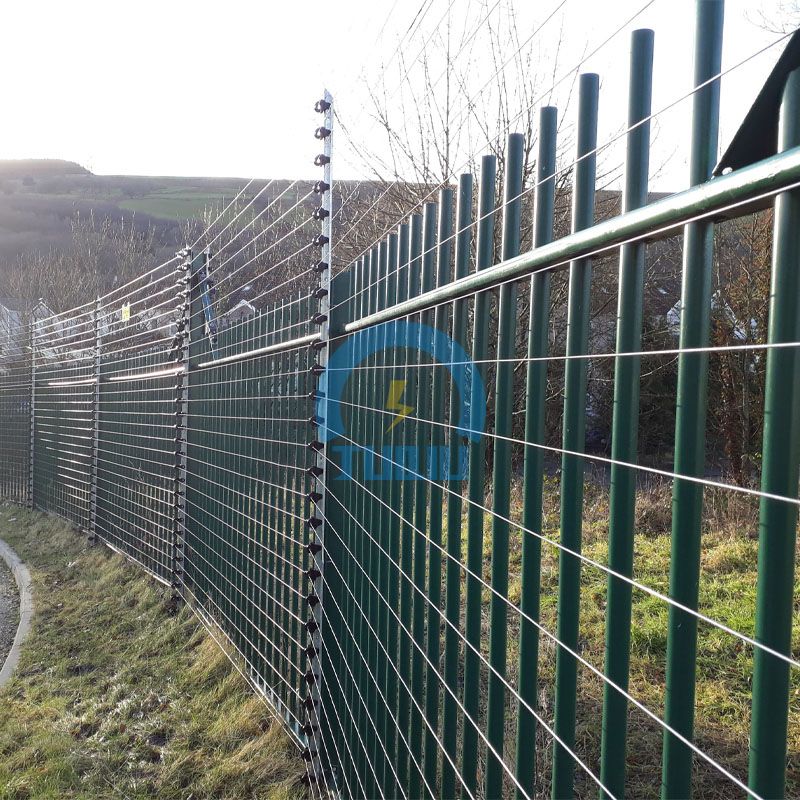A guide from Electric Fence Online
An electric fence system is a less-than-ideal environment on which to conduct electricity. Along the course of the average fence there are many conditions that will divert or impede the flow of electricity. Collectively, these conditions are known as the `fence load '.
Weeds or vegetation growing on the fence line is the most common culprit contributing to a heavy fence load. Green plants draw voltage and amperage from the fence to earth. Other circumstances can rob the fence of voltage and amperage. Cracked or broken insulators, or insulators of a poor design will allow electricity to leak to the fence post and down to earth. Sagging or broken wires can contact un-insulated wires or the ground. Wet weather will magnify all of these problems. When enough conditions exist to draw all of the electricity produced by the energiser from the fence, the fence is said to be `shorted out '.
Rusty wire, poor splices, or wire of insufficient diameter to carry the flow of voltage and amperage also contribute to fence load. These problems do not draw voltage and amperage to earth, but they do impede the flow of electricity along the fence, contributing to the fence load.
Even the length of the fence contributes to the fence load. The longer the fence, the less ability (or greater capacitance) it has to store the energy supplied by the Energiser. On very long fences, capacitance can become a major contributor to the fence load.

Proper construction with quality components, installing an adequately powered energiser, a proper earth installation and good management practices are the key to keeping fence load under control.
Inadequate earthing is the most common failure in electric fence operation. See the Earth Return System section.
In areas where heavy snow and ice are common, you may need to make additional earthing measures. Most people do not realise that snow or rainwater will not conduct electricity. Frozen ground also reduces the flow of current. When animals are to be left out in electric fenced areas in frozen snowy conditions you can improve the electric fence function by running a live/earth return system.
Three-step onsite security
Related links:Woven Wire Mesh vs. Welded Wire Mesh
What are the 4 types of steel?
What is the use of aluminum circle?
What are the Pros and Cons of Titanium?
What are the specifications for razor wire fence?
Guide to Kyanite Crystal: Meaning, Healing Properties & Uses
Graphite: Properties, Uses, Structure
Electric fences can offer enterprises the ability to not only deter trespassers but detect and delay them as well. Smart criminals will always favour a weak target rather than one presenting a challenge, so signs of an electric fence will often make them look elsewhere for a more vulnerable victim. If criminals persist and attempt to penetrate the fence, they’ll receive an electric shock, and if this doesn’t deter them, it will certainly delay them long enough for you to respond. Additionally, if the fence is connected to an alarm system, they will also be detected long before they can cause damage or commit acts of theft.
Easy to set-up
While a professional installation is always recommended for maximum security, electric fences are renowned for how easy they are to set up, and electric fence toppings can also be added to existing fences to give them a powerful upgrade to shore up your defences.
Defended against the elements
Commonly crafted from steel or aluminium, the latest electric fence solution uses a specially formulated powder coating to safeguard electric fences against rust. Protection from oxidation is key for security fencing as rust causes iron alloys such as steel to lose structural integrity. This results in them becoming brittle and more prone to breaking.
Overall, electric fences are extremely low maintenance and weather-resistant. Patrols to remove any unwanted debris against the fence and routine checks on connections and voltage is all that is typically required.
What is Molded Pressed Graphite ?
Unveiling the Marvels of Carbon Electrodes: A Sustainable Solution for a Greener Future
What is anti-fingerprint stainless steel?
What is a steel strand?
What is the easiest countertop to maintain?
What year did they start using fiberglass?
What is fiberglass e glass?
1492
0
0
Related Articles
-
438
0
0
-
448
0
0
-
430
0
0
-
414
0
0
-
439
0
0
-
444
0
0
-
484
0
0
-
442
0
0


Comments
All Comments (0)